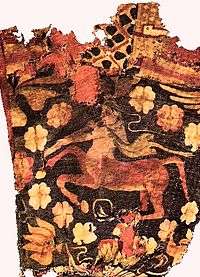Sampul tapestry


The Sampul tapestry is a Hellenistic woolen wall-hanging dating from 3rd–2nd century BCE found in Sampul, Tarim Basin, China.[1]
Description
The full tapestry is 48 cm wide and 230 cm long.[2] The centaur fragment is 45 cm by 55 cm, warrior's face fragment is 48 cm by 52 cm.[3] The recovered tapestry only constitutes the left decorative border of what would be a much bigger wall hanging.[4]
The tapestry depicts a soldier, probably Greek, and a centaur.[5] Accounting for the losses, the soldier would be about six times as tall as the centaur.[6]
Due to the findspot's heavy looting, the exact date of the textile is uncertain; it's been variously given as: 3rd century BC to 4th century AD,[7] Han period (206 BC to 220 AD),[8] 2nd century BC to 2nd century AD,[9][10] or 3rd to 2nd century BC.[11]
The tapestry is made of wool.[12]
It is probably a Greek work from Central Asia.
It uses more than 24 threads of different colours.
The soldier has Western-looking, probably Greek, handsome features.[13] He is notably blue eyed.[14] He is identified as a warrior by the spear he is holding in his hand as well as a dagger tucked on his waist.[15] He wears a tunic with rosette motifs. His headband could be a diadem, the symbol of kingship in the Hellenistic world, as represented on Macedonian and other Greek coins.
The centaur is playing a horn while wearing a cape and a hood.[16] Surrounding him is a diamond-shaped floral ornament.[17]
Discovery
The tapestry was excavated in 1983–1984 at an ancient burial ground in Sampul (Shanpula), 30 km east of Hotan (Khotan), in the Tarim Basin.[18]
The tapestry was, curiously, fashioned into a pair of man's trousers (all the other trousers found in Sampul had no decoration).[19] This indicates that it may have been used as a decorative trophy.
Origin
The tapestry probably comes from the Greco-Bactrian Kingdom in Central Asia.
The technique used for the tapestry, with more than 24 threads of different colours, is a typically western one.
The centaur's cape and hood are a central Asian modification of the Greek motif.[20] The fact that he plays a horn also distinguishes him from the Greek prototypes.[21]
Flower diamond motif on the warrior's lapel are of central Asian origin.[22]
Certain motifs, particularly the animal head on the soldier's dagger, suggest that the tapestry originated in the kingdom of Parthia in northern Iran.[23]
Rome has also been proposed as a possible source.[24]
Significance
The existence of this tapestry tends to suggest that contacts between the Hellenistic kingdoms of Central Asia and the Tarim Basin, at the edge of the Chinese world occurred from around the 3rd century BCE.
Exhibition history
The tapestry is on permanent display in the Xinjiang Museum, Ürümqi, China.[25]
Centaur and head fragments of the tapestry have been a part of a major exhibition China: Dawn of a Golden Age, 200–750 AD, held at the Metropolitan Museum of Art, New York, from 12 October 2004 to 23 January 2005.[26][27]
From 18 February to 5 June 2011, they were displayed at the Penn Museum, Philadelphia, in exhibition Secrets of the Silk Road.[28][29]
See also
| Wikimedia Commons has media related to Sampul tapestry. |
Notes
- ↑ Wood 2002, p. 37, p. 255
- ↑ Hansen 2012, p. 285, fn. 6
- ↑ Zhao 2004, p. 194
- ↑ Zhao 2004, p. 194
- ↑ Time Life 1993, p. 81; Wood 2002, p. 37; Hansen 2012, pl. 13 image + text, p. 202
- ↑ Zhao 2004, p.195
- ↑ Hansen 2012, pl. 13 text
- ↑ Time Life 1993, p. 81
- ↑ Zhao 2004, p. 194
- ↑ Image gallery for the Secrets of the Silk Road exhibition at the Penn Museum
- ↑ Wood 2002, p. 255
- ↑ Wood 2002, p. 37; Zhao 2004, p. 194
- ↑ Time Life 1993, p. 81; Wood 2002, p. 37; Hansen 2012, p. 202
- ↑ Time Life 1993, p. 81
- ↑ Zhao 2004, p. 194; Hansen 2012, p. 202
- ↑ Hansen 2012, pl. 13 text; Zhao 2004, p. 194
- ↑ Zhao 2004, p. 194
- ↑ Wood 2002, p. 37, p. 255; Zhao 2004, p. 194; Hansen 2012, p. 201
- ↑ Hansen 2012, pl. 13 text, p. 202
- ↑ Zhao 2004, p. 194; Hansen 2012, pl. 13 text
- ↑ Zhao 2004, p. 194
- ↑ Hansen 2012, pl. 13 text
- ↑ Hansen 2012, p. 202
- ↑ Hansen 2012, p. 202
- ↑ Wood 2002, p. 255
- ↑ Zhao 2004
- ↑ China: Dawn of a Golden Age, 200–750 AD at the Metropolitan Museum of Art
- ↑ Sheng 2010, p. 33, pp. 38–39
- ↑ Secrets of the Silk Road at the Penn Museum
References
- China's Buried Kingdoms. Time Life. 1993. ISBN 1-84447-050-4.
- Valerie Hansen (2012). The Silk Road: A New History. Oxford University Press. ISBN 978-0-19-515931-8. google books preview
- Frances Wood (2002). The Silk Road: Two Thousand Years in the Heart of Asia. London: Folio Society. ISBN 0-520-24340-4. google books preview
- Zhao Feng (2004). "Wall hanging with centaur and warrior". China: Dawn of a Golden Age, 200–750 A.D. Metropolitan Museum of Art. pp. 194–195. ISBN 978-1-58-839126-1. pdf online